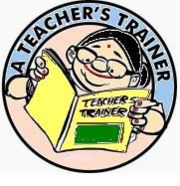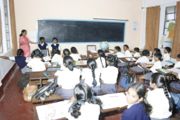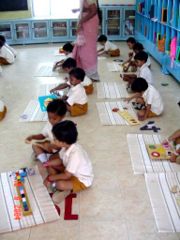GROUP WORK
WHAT IS SMALL GROUP WORK?
Human interaction in a society takes place in several forms. The most common form is interpersonal interaction between two persons. Looking at our daily routine, it is evident that a large number of our activities throughout the day require interpersonal interaction, that is, interaction with one or the other person.
A small group is a collection of more than two persons. It is not only interpersonal. Usually, a small group has a common objective, stable membership, a clear boundary in terms of physical space and time. The importance of a small group lies in the fact that experience can be shared and reflected upon.
In educational terms, the process of interaction with others in a small group provides the motivation to learn as it generates ideas and helps in analyzing experience. Therefore, the importance of organizing small group activities in a training programme cannot be minimized. It not only promotes individual identity but also provides scope for expression of inherent talents. Moreover, it develops one’s efficiency in carrying out given assignments effectively. Organizing small group activities
In organizing small group activity, the size of the group is a crucial factor. The size of the group should be determined on the basis of:
(a) The total number of participants on a training programme.
(b) The type of group activity.
The size of the group can vary between 5-8. If a group is very big. The level of participation can suffer. The smaller the group, the higher the achievement.
The composition of the group need not always be homogeneous, though it can some-times be desirable. The feeling of cohesiveness emerges when all the members of the group work towards achieving a goal-in educational terms, completing a task.
Group leadership
Leaders are normally those who provide direction to others. Leadership in a group is based on the skills of managing a process and not on person. In small group dynamics, leadership is task dependent. Indeed, leadership functions are performed by different members of the group based on the demands of the task. In a group, it is possible to observe different leadership roles being played by different persons at various points of time.
Leadership role in a small group, however, has six functional dimensions:
- Setting up an agenda
- Calling a meeting
- Initiating discussion or group activity.
- Classification of goals
- Mediating, maintaining momentum of activity
- Evaluating group progress.
There are certain established group norms which, as far as possible must be adhered to. There must be willingness on the part of all members to participate, be reasonable, be un-aggressive, and be truthful. Each must allow the other the freedom of thought and the potential of each member must be tapped. There must be mutual respect between members of the group.
Example
A series of questions are given to the participants to discuss, come to a consensus and do a write up. One member of the group is elected secretary/reporter.
- What is observation?
- Who observes?
- Who is being taught during the observation?
- What is observation for?
- What can people do when they are observing.
Post-group work
After the group work is over, the conclusions arrived at can be shared with the rest of the class.
This sharing can be done through:
(i) reading/presenting a report of the conclusions
(ii) poster presentation, where the main conclusions are visually displayed.
The post group sessions should be interactive in nature. For example, it is not enough to display posters. Group members should describe/ explain to others what the posters mean, what they signify.
Workshops/practical sessions, these emphasize the completion of a task that has a highly specific, observable outcome. For example, preparing teaching materials including teaching aids can be a workshop activity.
- They provide for trainee cantered learning
- They establish a common experience, shared by all members of the group.
- All participants can be actively involved and their attention and motivation are therefore more easily maintained.
- Group work enables the practise of complex interpersonal skills.
- Group work focuses on the process rather than the product.
![]() The disadvantages of group work
The disadvantages of group work
- They require careful preparation and planning to be effective. A badly prepared group task has more negative effects than a badly prepared lecture
- Trainees might approach group work as ‘high relief’ from the more formal mode (lecture) of training
- Finding appropriate tasks is quite difficult.
| Given below is a worksheet prepared for a group work. Do you agree with its contents? If not what changes would you like to make to it?
A WORK SHEET FOR GROUP WORK In groups, discuss the organizing an exhibition with the theme ‘Non-conventional energy’ Plan : The number of exhibits_____________________________________________ The type of exhibits_______________________________________________ The space required_________________________________________________ Any special needs (like a generator)_______________________________ The persons who will attend the exhibition_________________________ The timings________________________________________________________ Inauguration and closing___________________________________________ Prizes for best exhibits___________________________________________ How long it will take to set up____________________________________ Any other points___________________________________________________ (Present your groups plans to the whole class. You can prepare. Posters/charts displaying your groups’ decisions.) |



